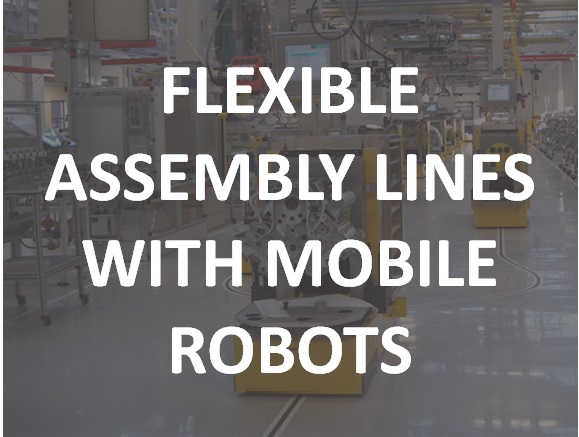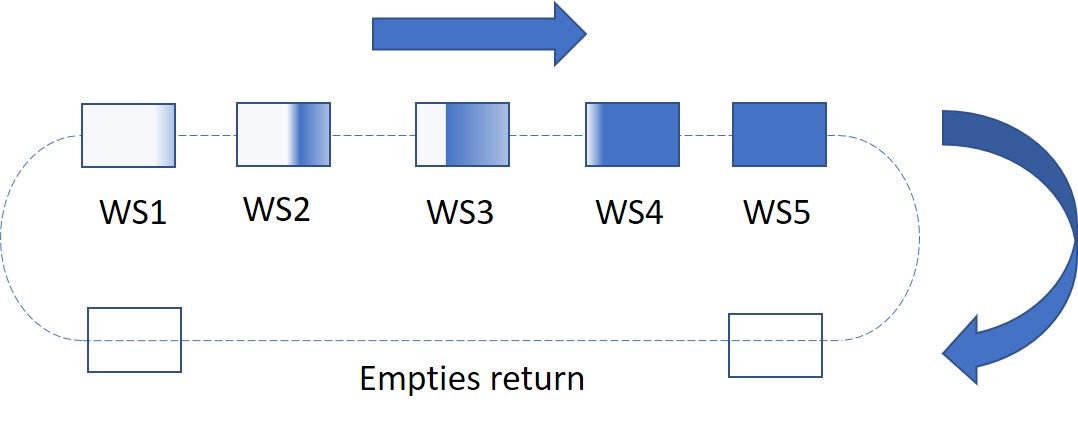Boost production with AGV Flexible Assembly Lines
Forget about expensive and heavy assembly line equipment such conveyors, cranes, etc.
Automated Guided Vehicles substitute traditional assembly concepts and open a world of manufacturing possibilities to enhance production output.
Boost Production with AGV Flexible production line

What is a flexible assembly line with Automated Guided Vehicles?
An assembly line is one of the main and more interesting Automated Guided Vehicle applications.
The AGV is the assembly line itself.
The idea is to use AGVs instead of typical physical structures such floor chain, moving mat, conveyors, overhead cranes… all of them are lines that requires important civil works for installation.
The AGVs carry the initial (not finished) product to be produced or assembled along the production line and the operators or robots will step by step modify, add, transform, thus will add value from the basic initial product until the finished product.

Typical AGV applications in the manufacturing industry are:
- Serving material to production lines (raw material, kits, work in progress materials, etc)
- Transporting finished products from production lines
- Managing warehouses or buffers of boxes, containers, etc with finished materials, raw material, etc.
Let’s say that until here, nothing changes in the manufacturing flow and the strategy of the AGV user.
In the past, there were manual vehicles, and now, there are AGVs. It’s a matter of payback, safety, ability to program logistics flows, etc.
AGVs “acting” as production lines change everything and open an incredible world of possibilities to improve factory output
What are main advantages of an AGV production line?
1) AGV advantage number 1: Flexibility
Flexibility1: Path flexibility
Why is it called production line? Because it is a “line”. In the typical configuration, the product follows the line from the beginning to the end. The flow is physically constrained to that line. So, something like this:

With the AGVs performing a flexible assembly line, you are not obliged to follow a line, and you can create as much as deviations and external positions as you wish. You can create deviations for quality check, additional operations, product customizations, etc.

With AGVs you can take advantage of both worlds: synchronous and asynchronous production. You can have the perfect combination of both. Flexibility facilitates production customization
Flexibility 2: AGV Flexible assembly line allows scalability
You can increase line dimension easily just adding some new workstation and maybe adding AGVs. No need of civil works.
Imagine that you know that next four months you have to assembly a defined product for a new market that requires a special additional operation. It’s done, just add an additional working station. Once you have finished your special order, just can come back to previous situation.

Why to invest so much from the beginning?
Maybe you start a new product model and you probably have a production ramp-up in the next two or three years. In this case you can program to increase AGV assembly line, step by step, together with your production needs.
Flexibility 3: AGVs allow Assembly line relocation
You can easily relocate your agv flexible assembly line in another area of your plant… or you can even move the line to another plant even if it is abroad without expensive civil works.
AGV Advantage number 2) Software is king. Industry 4.0, 5.0, 6.0 … never-ending.0

If your assembly line is done by AGVs, you have access to a world of information and you can control, check, trace your product like never.
AGVs can integrate with other PLCs, tool, robots in the production line and exchange information with any element related to the production process.
You can define AGV actions depending on many other factors. For example, in a stop&go line, you can define that the AGV will move to next station only if operator has performed a given action (reading a bar code, installed a subassembly, etc).
The AGV becomes an intelligent part of the whole production system with infinite possibilities of integration with factory MES.
AGV Advantage numer 3) Possibility to integrate AGV Assembly line with other logistics flows
With AGVs performing assembly line tasks, it is possible to integrate assembly line flow with other flows even managed by AGVs.
It could be possible to integrate the assembly line with the supply of kits to the assembly line. You could have an AGV going forward with the kitting needed for assembly and another agvs being the assembly line, both could be synchronized at same speed.

For example, you could integrate the assembly line with the delivery of finished goods to the warehouse, minimizing the number of forklifts in plant. It would be an integration of:
- assembly line + trasportation of finished products from production lines

AGV advantage number 4) Automated guided vehicles improve operator ergonomics and safety
AGVs can incorporate many tools improving operator ergonomics such lifting tables, rotating devices, etc. These tools will minimize operator movements and will avoid non ergonomic operations.
TESLA Assembly line by FROG-OCEANEERING. Click th epicture to redirect.
It is also possible to added safety tools. For example
- Safety sensors that will not allow AGV movement until a certain part is properly blocked or unblocked.
- Safety sensors that will block the AGV movement in case an operator is detected in a defined position.
AGV assembly line concerns and solutions
Traditional synchronous assembly lines ensure line speed. How can I be sure that all the AGVs maintain a given speed?
AGVs count on safety encoders that ensure speed required.
What is minimum speed reachable by an AGV assembly line?
AGVs are typically produced to run as much as possible. Nevertheless, with good brushless motors and appropriated reduction ratios AGVs can move at 0,1 m/min (3,9 inch/min).
What about batteries? How much do AGV batteries last?
Like any other AGV project, it is necessary to perform a right AGV battery balance analysis.
There are mainly two options:
First, and most suitable option is “Opportunity Charging” for AGVs, where AGVs go to defined charging stations and performs charging while waiting for a new mission to be accomplished. Doing this way, the AGV could never need to change the battery.
This is a great solution for asynchronous assembly lines where we are sure that the AGV will be stopped for a while.
Otherwise, it is possible to install opportunity charging stations in the way back with empties.
Second option is AGV battery exchange strategy, where batteries must be substituted when reached a certain charging level.
If you want to know more about AGV recharging strategies and battery options, I recommend reading these two articles:
AGV Automated Guided Vehicles Battery charging solutions
AGV Automated Guided Vehicles types of Battery
What are best AGV navigation technologies for AGVs assembly lines?
Best navigation technologies are:
Magnetic tape: reliable, easy to install and modify, cheap)
Laser navigation AGV (LGV): reliable, allows complex paths, no structures on floor needed
In this article you can learn further about different AGV navigation methods.
Types of AGV Navigation Systems - Automated Guided Vehicles
Don't by shy... change the way you "see" assembly lines and boost production!

